After a remarkable 31-year absence, Luton Town have earned a sensational return from Championship to the top flight of English football.
Securing the coveted third and final promotion spot in the Premier League, they emerged victorious in the intense “most valuable game in the world” against Coventry City, triumphing 6:5 on penalties at the iconic Wembley Stadium.
Having finished third in the second division last season, behind promoted sides FC Burnley and Sheffield United, Luton Town’s ascent to the Premier League marks a significant milestone in their storied history.
The club last competed in England’s top division back in 1992. Still, their failure to meet the criteria for the transition to the newly formed Premier League resulted in their prolonged absence.
Luton Town’s promotion to the Premier League is akin to a football fairy tale coming true. Their journey to this achievement has been fraught with challenges, including a dramatic decline that led them to the fifth tier of English football and an arduous climb back up the ranks.
As recently as five years ago, the club found themselves playing their trade in the fourth tier. The historic Kenilworth Road stadium, with its modest capacity of just over 10.000 spectators, now becomes the smallest venue ever to host Premier League matches.
However, Luton Town‘s offensive prowess could have been more impressive during their promotion season. They managed to score a total of 61 goals, averaging just 1.13 goals per game, placing them in the 7th position in terms of goals scored. This indicates that their attack needed more efficiency and consistency.

On the other hand, Luton Town’s true strength lay in their defensive solidity. They conceded a mere 42 goals throughout the season, averaging only 0.78 goals per game.
This defensive record is commendable and played a crucial role in their successful campaign. The expected goals against (xG against) value was 52.29, suggesting that their goalkeeper, Ethan Horvath, performed exceptionally well by preventing approximately 10 goals that were statistically likely to be scored against them.
However, Horvath has returned to Nottingham Forest after his loan spell, potentially leaving a significant performance gap in the Luton Town goalkeeping position.

Despite their remarkable accomplishment, Luton Town faces an uphill battle in the upcoming Premier League season. With a current total market value of €39.850.000 and an average player market value of €1.420.000, they are unquestionably the biggest underdog among their top-flight counterparts.
Widely regarded as the number one relegation candidate, Luton Town’s ability to defy expectations and hold their ground in the fiercely competitive Premier League remains to be seen.
Their journey from the brink of oblivion to the pinnacle of English football is a testament to the resilience and determination of the club and its supporters, who will undoubtedly savour this remarkable chapter in Luton Town’s history.
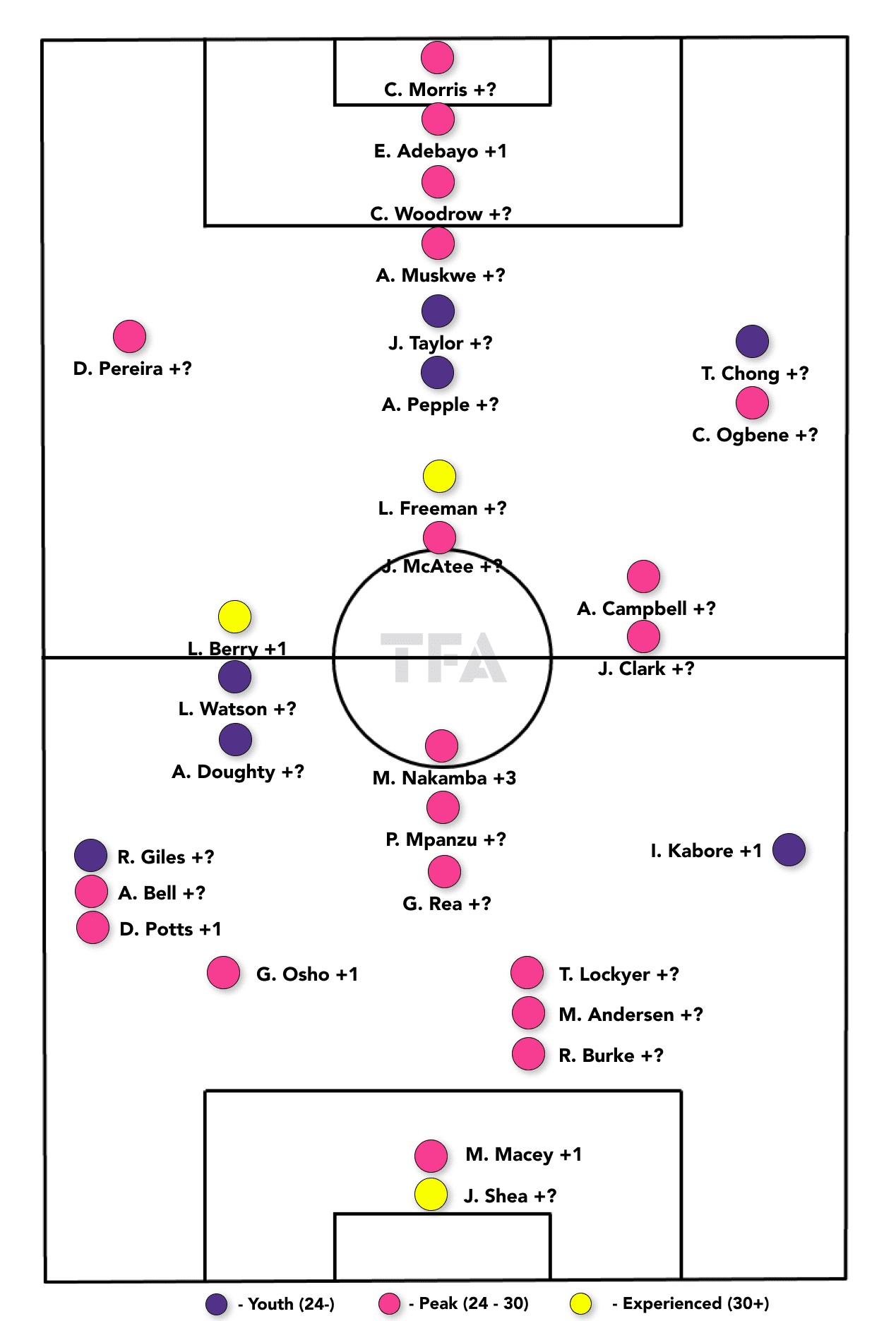
To maintain their defensive stability and mitigate the potential impact of Horvath’s departure, Luton Town will need to find a capable replacement in goal to uphold their impressive defensive record in the Premier League.
A solid defensive foundation will be crucial for their survival and success in the highly competitive top-flight of English football.
Besides the goalkeeper position, Luton Town need to gain experience and skill in midfield and on the wing. One player who has been acquired already combines both positions is Tahith Chong.
The 23-year-old Dutch youth international has generated a lot of interest at Luton Town for the upcoming season. With his extensive experience in the Premier League, Bundesliga, and Europa League, Chong brings a wealth of top-level competition know-how to the club. Luton Town’s decision to acquire him for a record fee of €4.7m underscores their belief in his potential.
Chong is a highly versatile player, capable of making an impact on both wings as well as in the forward position. In fact, he demonstrated his adaptability last season by playing in a central midfield role.
This versatility is a valuable asset for Luton Town, providing the manager with various tactical options and the ability to deploy Chong in multiple positions based on the team’s needs.
Standing at imposing 185cm tall, Chong’s physicality is a significant advantage he brings to the game. His stature and strength make him a formidable opponent for defenders, causing them trouble throughout the match.
His physical attributes, combined with his speed, directness, and vision, make him a challenging player to contain and a nightmare to play against.
His crossing ability will need refinement if he continues developing his wing play. Enhancing his final ball accuracy and delivery will make him an even more potent threat from wide positions. This aspect of his game is where Chong can focus on development to elevate his overall effectiveness further.
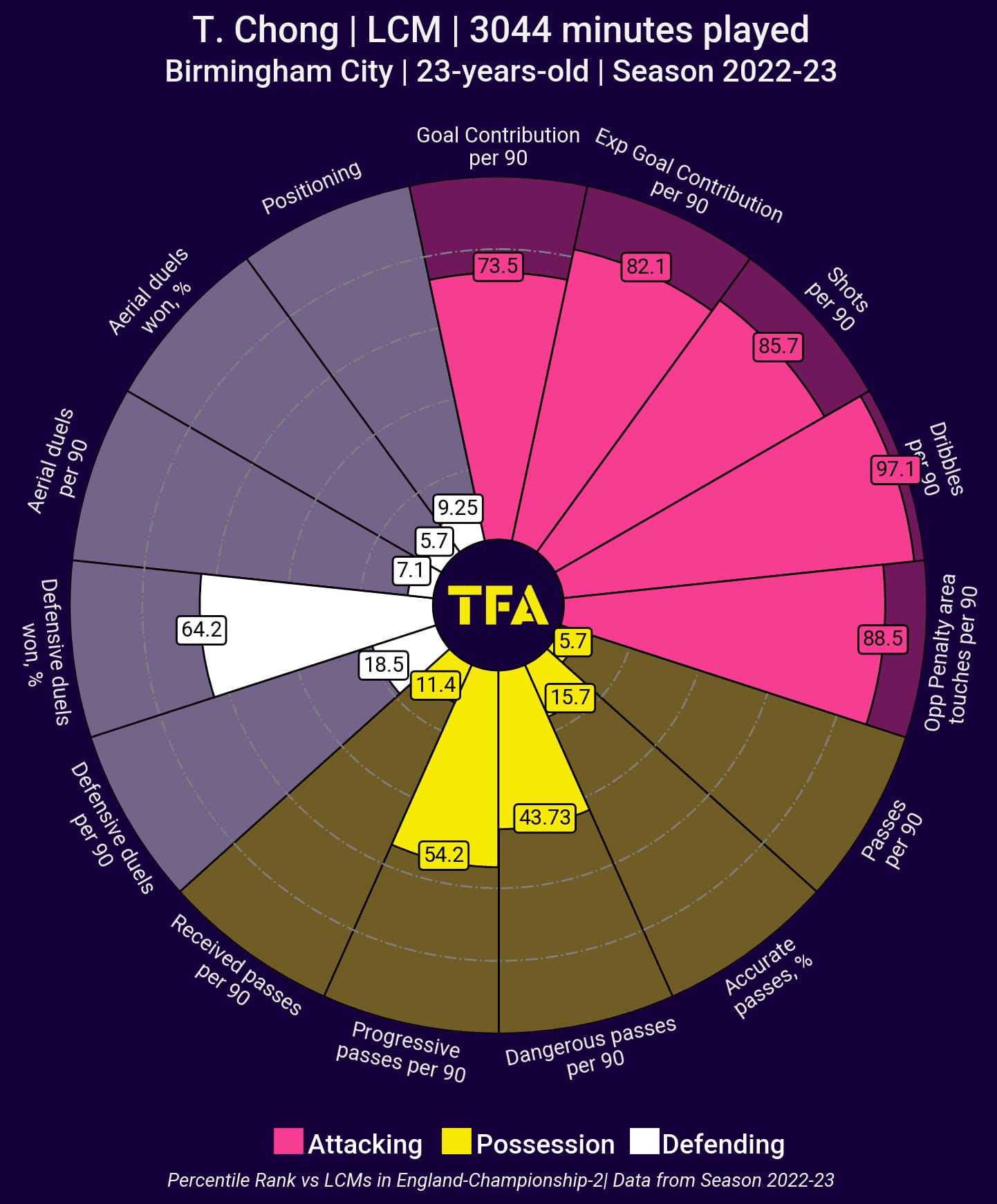
Considering his potential and skill set, Chong may also be utilised in a more central position next season. This adjustment could allow him to make better use of his strengths while minimising any limitations he may have in terms of crossing ability.
Playing a central role could unlock his full potential, allowing him to maximise his speed, directness, strength, and vision.
Attacking Phase
In the attacking phase of the game, Luton Town predominantly set up in either a 3-5-2 or 3-4-1-2 formation. A notable aspect of their approach is the positioning of their wing-backs. The left wing-back is deployed in an advanced and wide role, while the right wing-back operates more conservatively.
During the build-up phase, Luton Town showcases a structured approach, often adopting a 4-1 shape to initiate their attacking moves.
The team’s left-back plays a crucial role in their build-up strategy by pushing forward and occupying advanced positions on the pitch. This bold movement allows one of the centre-backs to shift into the vacated full-back position, providing additional width and options in the attacking areas.
Simultaneously, the right-back assumes a deeper position, forming a solid back four. This positioning ensures defensive stability while allowing the team to progress the ball forward confidently. Luton Town can effectively counter any potential opposition threats by maintaining a compact defensive line.
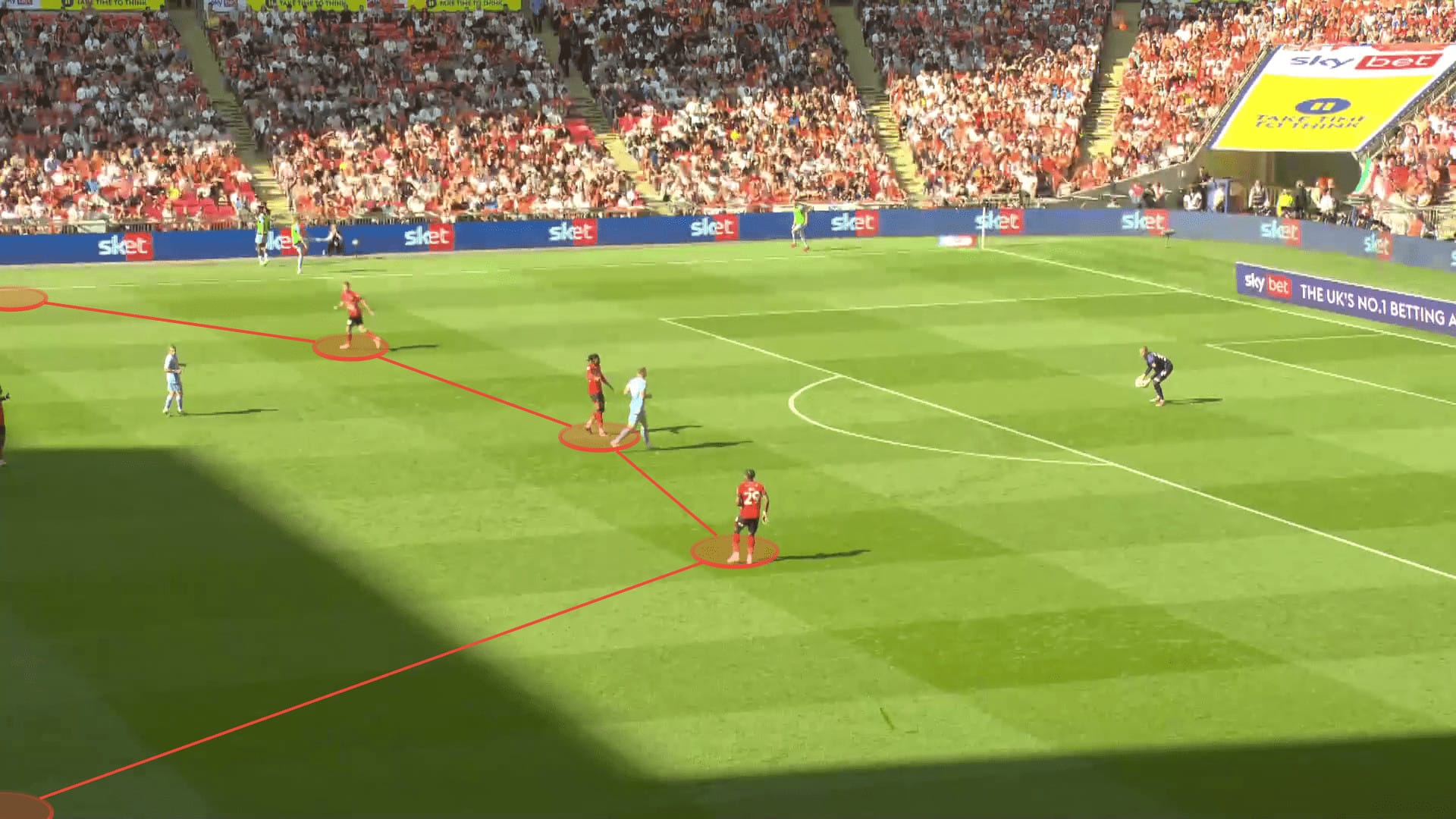
In the midfield, the central midfielders actively contribute to the build-up phase by pushing higher up the field. Their advanced positioning aims to support the team’s attacking movements and create passing options for the players in possession. These central midfielders act as key connectors, facilitating the transition from the defensive line to the more advanced areas of the pitch.
However, one challenge Luton Town faces in their build-up phase is the need for a winger. With a natural wide player, the team can effectively switch the play from one side of the pitch to the other.
This limitation can restrict their ability to exploit spaces and create scoring opportunities in wider areas. That is why, instead of attempting to play out from the back, they often opt to send long balls to one of their strikers.
Under the guidance of head coach Edwards, one key aspect of their attacking approach is the effective utilisation of Carlton Morris as a target for direct play. This strategy has proven successful, as Morris’s physicality and first touch allow him to receive long passes and effectively control the ball. His strong physique serves as an excellent asset, providing Luton Town with a reliable outlet in the attacking phase.
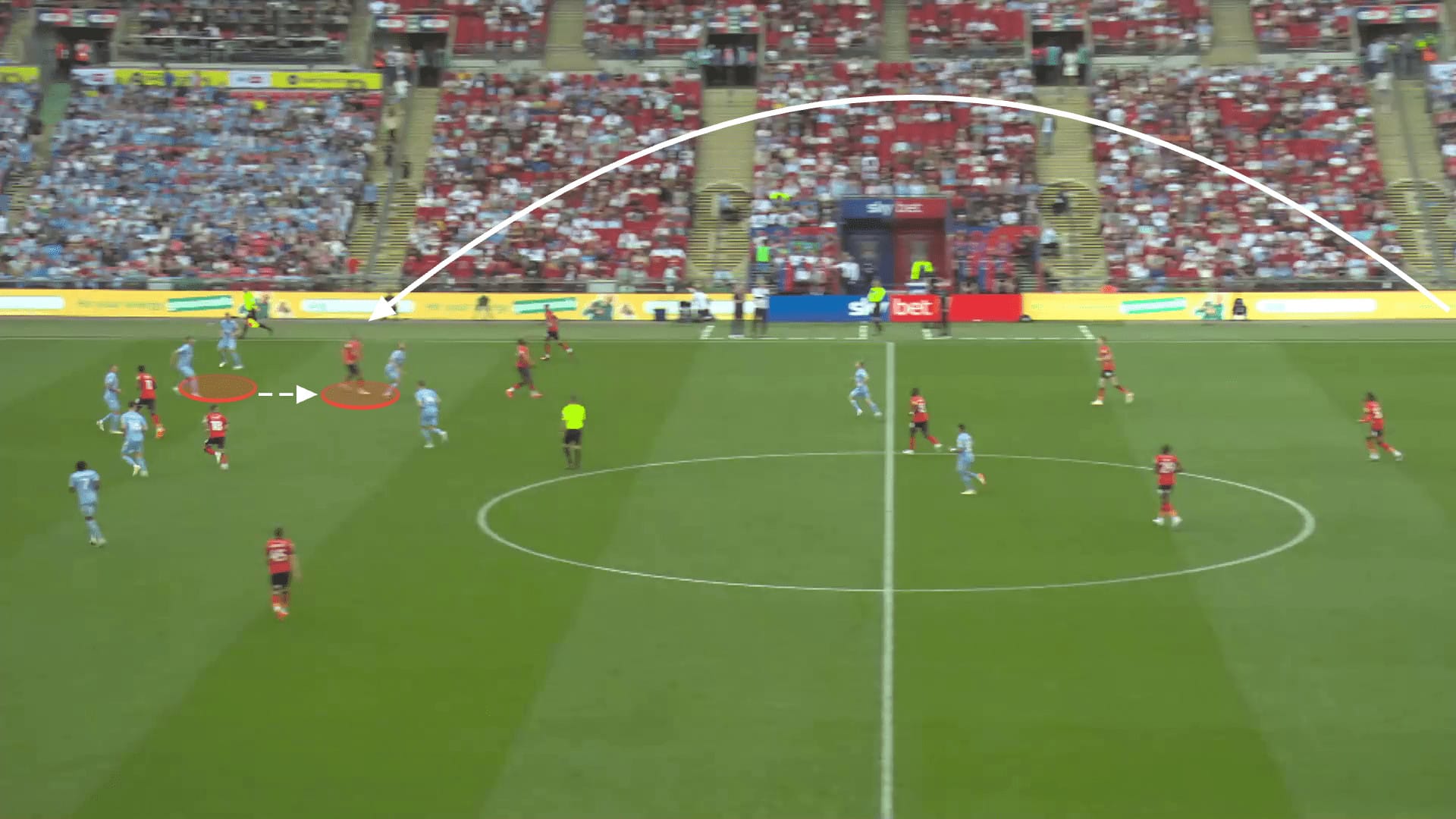
To complement their direct approach, Edwards encourages his team to identify and exploit spaces left by the opposition, particularly in midfield areas. Luton Town can penetrate the opposition’s defensive lines and access dangerous attacking areas by capitalising on gaps in the opposition’s midfield. This proactive mindset allows the team to create scoring opportunities and pressure the opposition’s backline.
While Luton Town’s direct and space-focused approach in attack can yield positive results, it can also become predictable without alternative tactics. This predictability makes it easier for the opposition defence to anticipate their moves.
Nonetheless, the team’s utilisation of their strengths, the effectiveness of Carlton Morris as a target player, and the exploitation of spaces left by the opposition are vital aspects of Luton Town’s attacking style.
Defensive Phase
In their defensive approach, Luton Town adopts a structured 5-3-2 formation. This system allows them to congest the central areas and limit the opposition’s opportunities to penetrate the middle.
The wing-backs play an essential role in Luton Town’s defensive approach. They engage high up the pitch, aiming to disrupt the attacking play of the wingers and prevent dangerous crosses into the box.
Their aggressive attempts to win the ball back often require the Luton midfielders to shift into fullback zones, ensuring that the wide channels are adequately defended. This flexibility in positional responsibilities demonstrates the team’s commitment to their defensive approach and their willingness to adapt to specific situations.
The centre-backs are free to push into midfield and actively disrupt the opposition’s build-up play. This assertive mentality not only showcases their confidence in their defensive abilities but also adds an element of surprise and unpredictability to Luton Town’s defensive approach.
By aggressively pressing and challenging for possession in midfield, they aim to unsettle the opposition and regain control of the game.
While Luton Town’s defensive approach has its strengths, there are also potential weaknesses to consider.
One possible vulnerability lies in the wing-backs’ high engagement with opposing wide players. This aggressive approach leaves spaces which could be exploited by intelligent movement or quick combination play.
Additionally, the positional adjustments required by the centre-backs to cover push up may disrupt the defensive organisation and expose temporary gaps in the central areas.
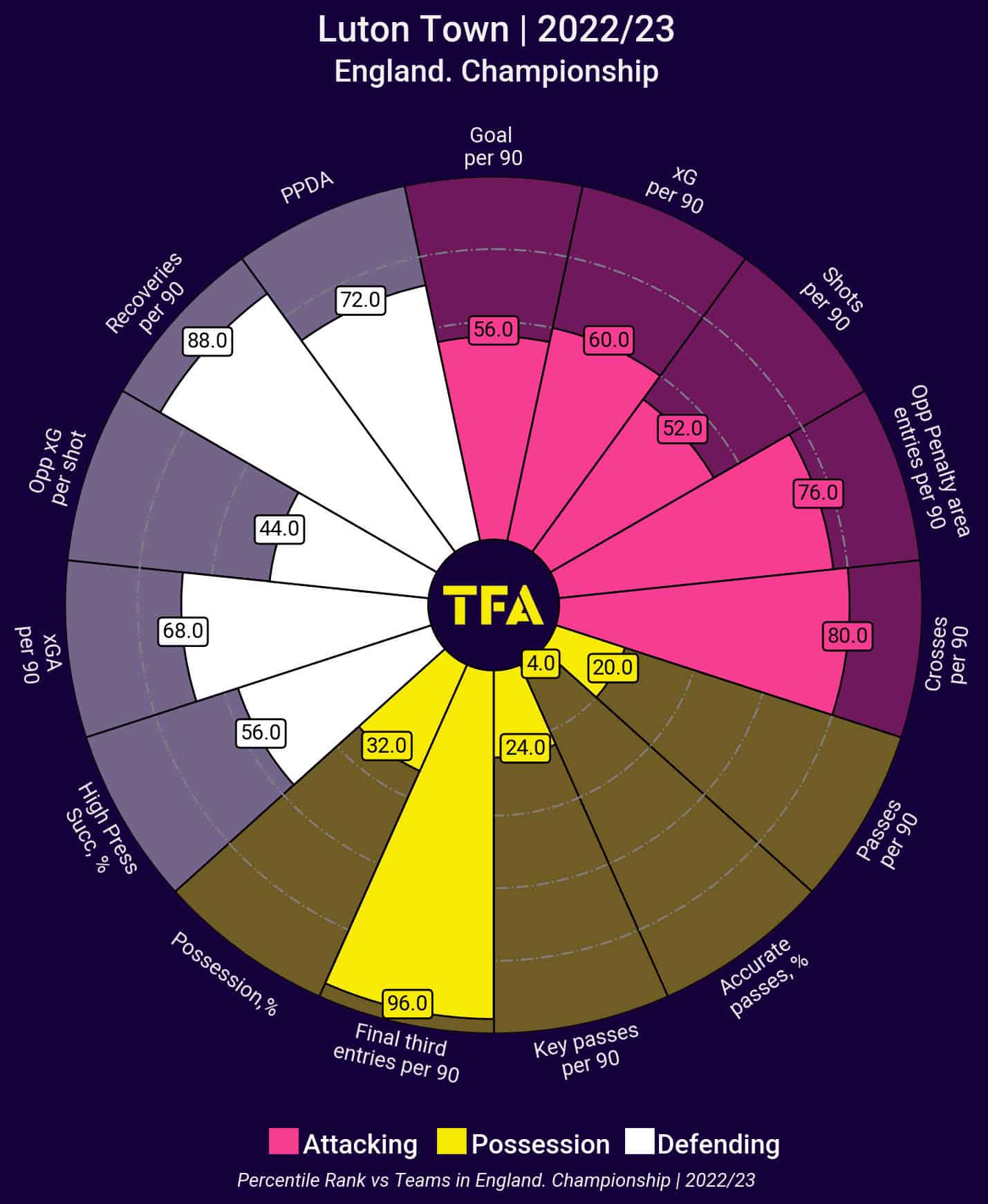
Rather than solely relying on a deep-lying defensive block, Luton Town adopts a proactive mindset, seeking to win the ball back in advanced areas. This aggressive mentality is reflected in their impressive statistics, ranking fourth in the Championship for their low PPDA (8.77) and third for their high challenge intensity of 6.9. They create turnovers and gain more opportunities to launch swift counterattacks by pressuring the opposition high up the pitch.
Transitions Phase
Luton Town’s approach in transitions is characterised by intensity. Luton Town ensures they are well-equipped to transition from defence to attack swiftly.
One key aspect of Luton’s transition game is their ability to time their counterpress effectively. They press the opposition immediately after losing possession, aiming to win the ball back quickly and disrupt any potential attacking moves. This prevents the opponent from gaining momentum and sets the stage for Luton’s dangerous transitions.
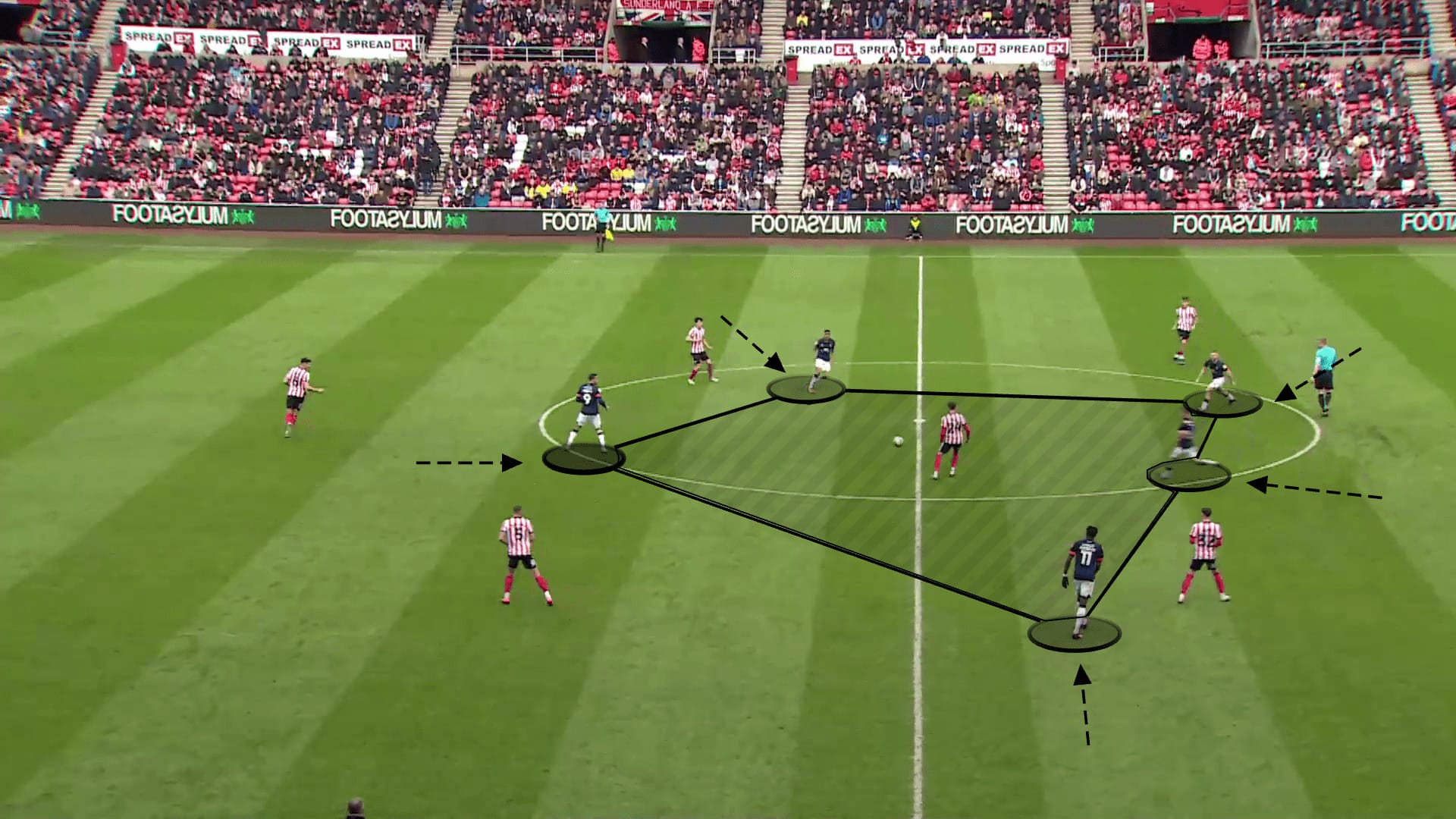
In these transition moments, all players involved in winning the ball back contribute to the resulting attack. Luton Town capitalises on their regained possession by launching rapid and incisive attacks, aiming to hurt their opponents before reorganising defensively. This collective effort in transitioning from defence to attack highlights their commitment to swift and direct play.
Analysing Luton’s high regains further emphasises their aggression. They have won the ball back 134 times this season and taken a shot within 20 seconds of doing so. This statistic showcases their ability to regain possession in dangerous areas and quickly shift the ball into those areas after winning it back. It highlights their threat by capitalising on turnovers and launching immediate attacks.
Overall, Luton Town’s approach in transitions showcases their emphasis on speed, intensity, and offensive aggression. They are adept at timing their counterpress, winning the ball back in crucial areas, and swiftly launching attacks to catch their opponents off guard. Their ability to transition quickly and effectively from defence to attack is a significant strength and a prominent feature of their game plan.
Luton’s crucial set-pieces
Set pieces have been a crucial aspect of Luton Town’s play, and their effectiveness in this area makes them a key weapon for the upcoming season. In fact, an impressive 22% of Luton’s goals last season have come from set pieces.
Luton Town have succeeded in set pieces due to their relentless effort to maintain possession. Whether it’s a corner kick or a free kick, they prioritise delivering the ball with precision and height towards the central area of the penalty box or towards the far post. This deliberate approach enables them to create threatening goal-scoring opportunities and pressure their opponents intensely.
Luton Town maximise their chances of winning aerial duels and generating goal-scoring opportunities by putting a lot of height on the ball and aiming for specific areas. This strategy plays to their strengths, mainly because they have players with strong aerial presence and heading ability. By delivering the ball into dangerous areas, Luton Town capitalises on their players’ skills and creates a significant threat in set-piece situations.
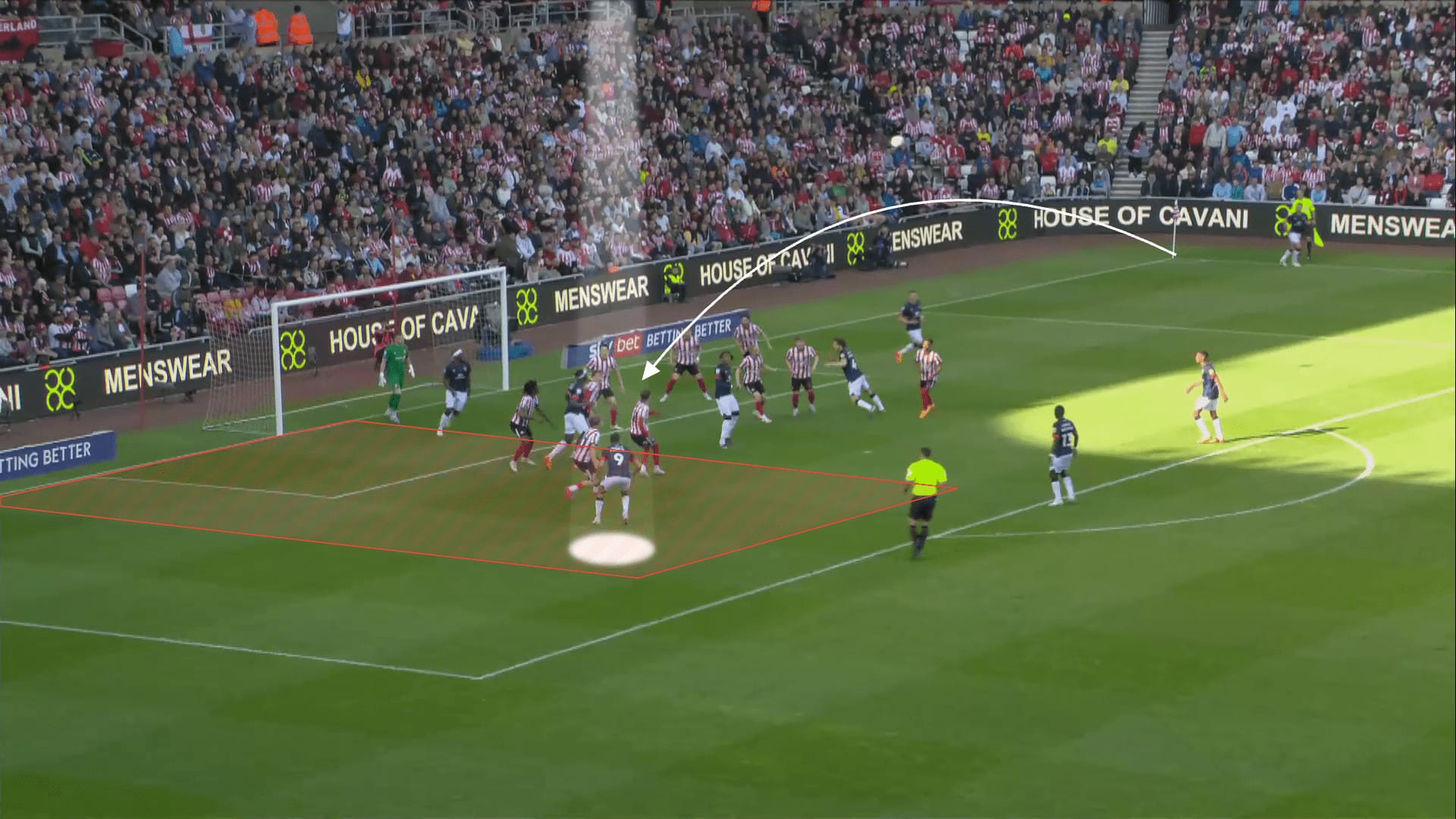
Furthermore, set pieces provide an opportunity for Luton Town to disrupt the opposition’s defensive organisation and create chaos in the penalty area — the delivery of the ball into the centre or to the far post forces defenders to react quickly, often leading to defensive lapses or marking errors. Luton’s players, positioned strategically to exploit these situations, can take advantage of any defensive weaknesses and find themselves in advantageous positions to score.
Set pieces can be a game-changer in football, providing opportunities for teams to score goals and gain an advantage over their opponents. Luton Town’s proficiency in this aspect of their game makes them a formidable threat. As they prepare for the Premier League next season, Luton Town will continue to rely on their strong set-piece play as a critical component of their offensive strategy.
Key Player: Carlton Morris
Carlton Morris, the 27-year-old striker, is set to play a vital role for Luton Town in the upcoming season despite his lack of Premier League experience. Morris has spent several seasons on loan from his former club Norwich, gaining valuable playing time and honing his skills. Having been acquired by Luton Town from Burnley last season, Morris brings a wealth of potential and key attributes to the team.
One of Morris’ main strengths lies in his effectiveness within the opposition’s penalty area. He consistently finds himself involved in the action, with numerous touches in the box. This demonstrates his ability to position himself well and create scoring opportunities for himself and his teammates. His high shot output showcases his willingness to take on goal-scoring chances, providing Luton Town with a potent attacking threat.
Morris also stands out for his above-average goal contributions, indicating his ability to score goals and contribute to the team’s overall offensive output. His ability to find the back of the net and create opportunities for others makes him a key player in Luton Town’s attacking strategy.
Furthermore, Morris excels in aerial duels, regularly winning battles in the air. This ability allows him to receive a significant number of passes per match, both in terms of flat ground passes and high crosses. His proficiency in aerial contests provides an additional dimension to Luton Town’s attacking play, enabling them to vary their approach and exploit opposing defences in different ways.
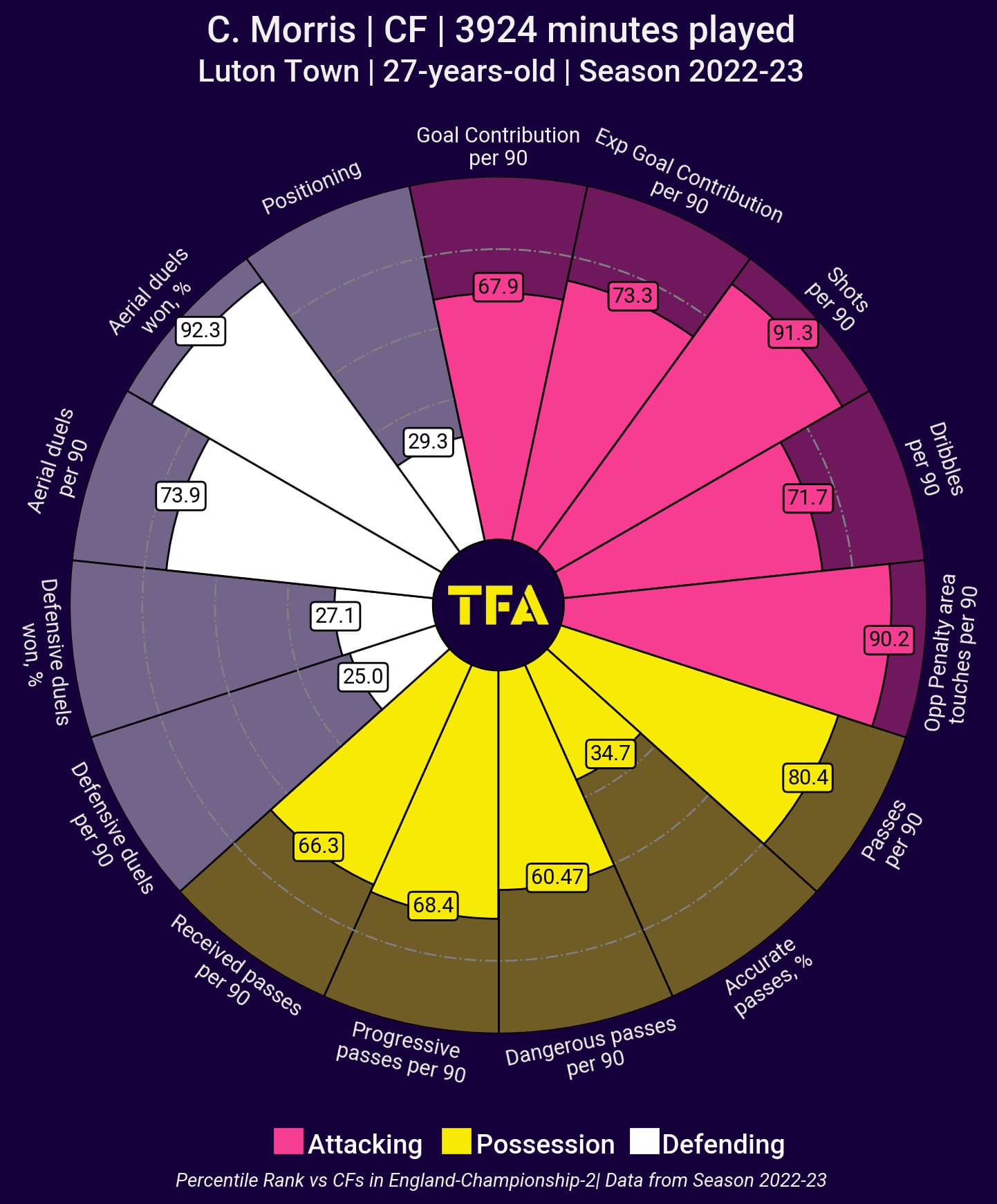
While Morris may lack Premier League experience, his proven goal-scoring ability, effectiveness in the penalty area, aerial prowess, and high shot output make him a crucial player for Luton Town in their upcoming campaign. His contributions will be pivotal in their quest for success as they compete against the top clubs in English football’s elite division.
One To Watch This Season: Elijah Adebayo
Elijah Adebayo, the 25-year-old striker, is emerging as a player to watch at Luton Town for the upcoming season. Although he lacks Premier League experience, Adebayo’s journey through the youth ranks at Fulham, where he spent 10 years, has provided him with a solid foundation for his development. In recent seasons, he has showcased his skills in various competitions, including the Premier League 2, League One, and the Championship.
Adebayo’s main strengths lie within the opposition’s penalty area. He excels at getting involved in the action, consistently making crucial touches and creating opportunities in dangerous areas. His ability to find space and position himself well in the box makes him a constant threat to opposing defences.
Adebayo’s mobility sets him apart from other strikers, offering a different dimension to Luton Town’s attacking play.
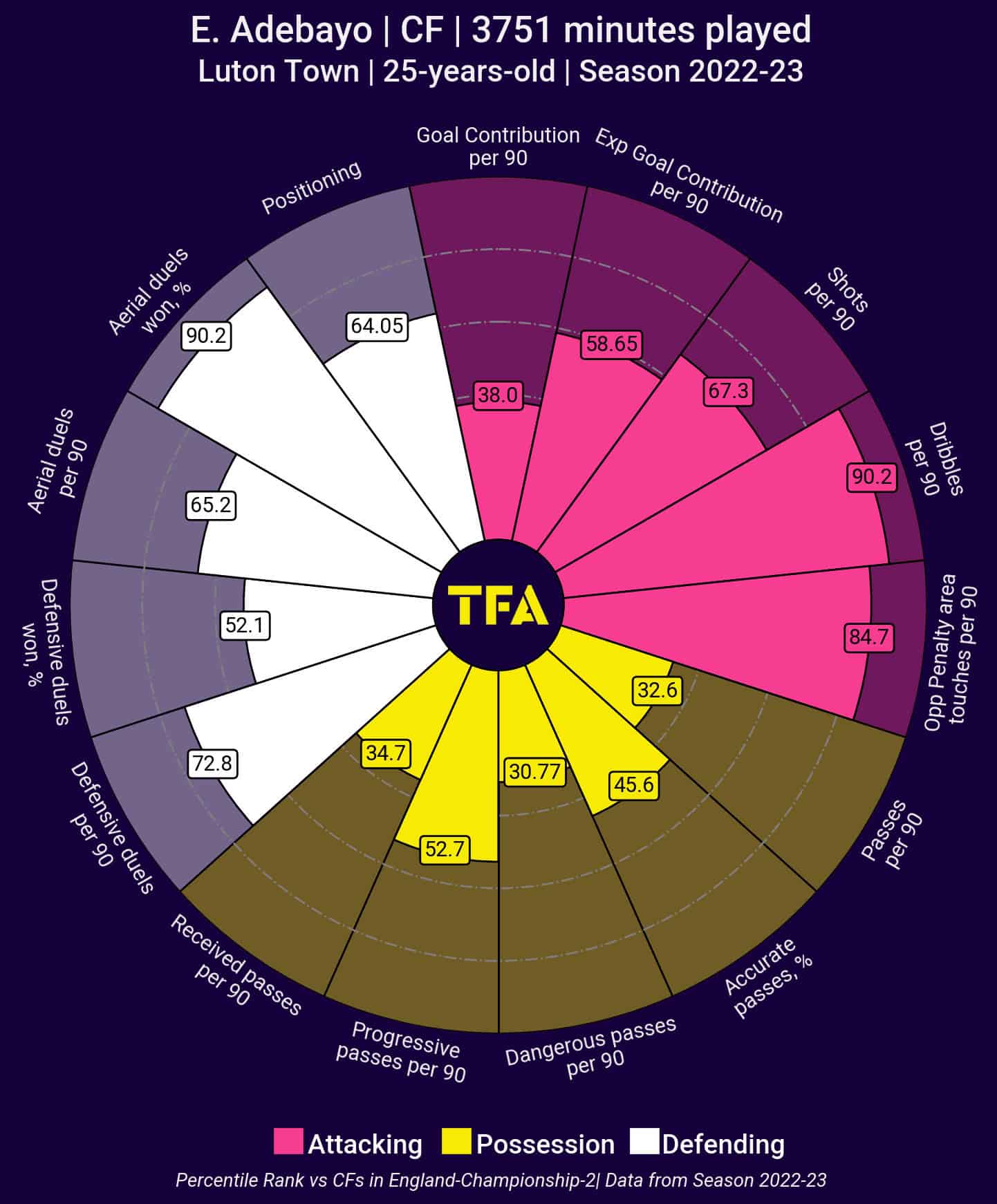
Standing at an imposing 193cm tall, Adebayo is a formidable presence in aerial duels. His height and physicality give him an advantage when contesting headers, making him a valuable target in set-piece situations.
Moreover, his willingness to engage in defensive duels highlights his work rate and commitment to the team’s overall performance. This defensive contribution positions Adebayo as a potential option as a pressing forward, capable of disrupting the opposition’s build-up play.
TFA Verdict: 19th
As we all know, them even being in the Premier League is a miracle so staying up would be an even bigger one. It’s easy to fall into the romance of their story and think that they could surprise the world and finish mid-table. But, being realistic, this is now a very good Championship side who get a season in the Premier League to reinvest into their future. Not finishing bottom will be a great achievement and they will get a few historical results – Rob Edwards can only enhance his reputation with this campaign.





Comments